
Braunschweig
Braunschweig at 27.2903°S and 30.6718°E at 1152m altitude, is a church with some auxiliary buildings, there used to be a school.
History
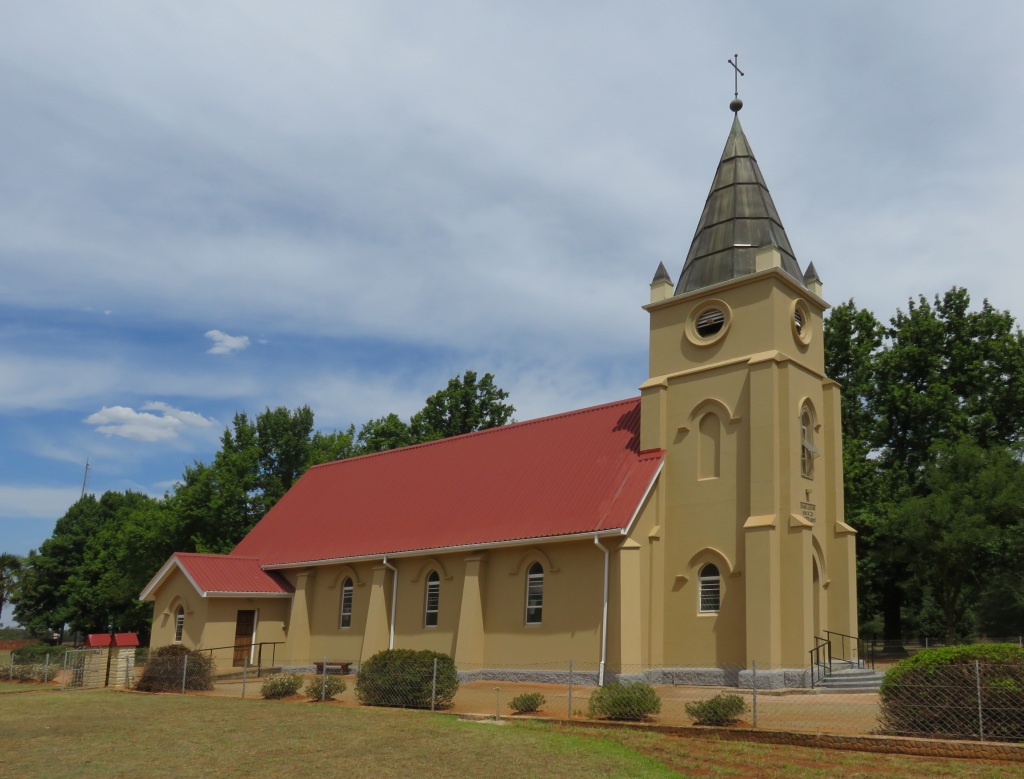 It had its origin from the Hermansburg Mission Society (HMS) just like Lüneburg and in fact was originally the same community.
It had its origin from the Hermansburg Mission Society (HMS) just like Lüneburg and in fact was originally the same community.
But than there was a split, the split happened in 1892 and had to do with church politics in far away Germany. It started with the war between Prussia and the Kingdom of Hanover in 1866. Prussia won that war and there was a concern in the HMS (which was situated in the Kingdom of Hanover) that the Hanover Lutheran State church would be incorporated into the Prussian Unitary church. The HMS didn't like that because of nationalism and because the Prussians allowed secular marriage. Theodor Harms (the MD of the HMS) thus decided to split from the state church and to form his own Free Lutheran church.
In 1890 there was an agreement of merger between the Free Lutheran church and the state church. Some members of the HMS objected and the ripples went as far as South Africa (and Australia by the way). Here in Lüneburg the majority of members decided for the unification and because they were in the majority they could stay in the Lüneburg congregation, whilst the members (105 of them) that opted against the new unity church, formed a new congregation and named it Braunschweig.
This split is still existing today. The split was not a schism. i.e. difference in beliefs, both subscribe to the Augsburg confession as a basis of their beliefs. It was rather a political separation. Repeatedly I was told that the relationship between the two parts of the same church is excellent.
Church

 A church and a school was built in 1896/97 (see picture) on ground donated by August Hinze. Initially the church was called Christuskirche Lüneburg; later Lüneburg-Hermansburg and only in 1957 Christuskirche Braunschweig. Actually strange it took all those years, because in the transfer document of 1895 it was already referred to as Braunschweig. And the reason for that was that August Hinze, who came to South Africa in 1858 as a Hermansburg colonist, originated from the town Schöppenstedt near Braunschweig.
A church and a school was built in 1896/97 (see picture) on ground donated by August Hinze. Initially the church was called Christuskirche Lüneburg; later Lüneburg-Hermansburg and only in 1957 Christuskirche Braunschweig. Actually strange it took all those years, because in the transfer document of 1895 it was already referred to as Braunschweig. And the reason for that was that August Hinze, who came to South Africa in 1858 as a Hermansburg colonist, originated from the town Schöppenstedt near Braunschweig.
That older church was replaced by the new one as it is standing today, so I thought. It was inaugurated in 1928. This is what the picture above on the right shows, the inauguration. The caption under the photo in the album that I took the picture of actually reads "Turm Einweihung 1928" , that is inauguration of the tower. This leads me to the conclusion that the building as such was retained, but refurbished, modified and improved.
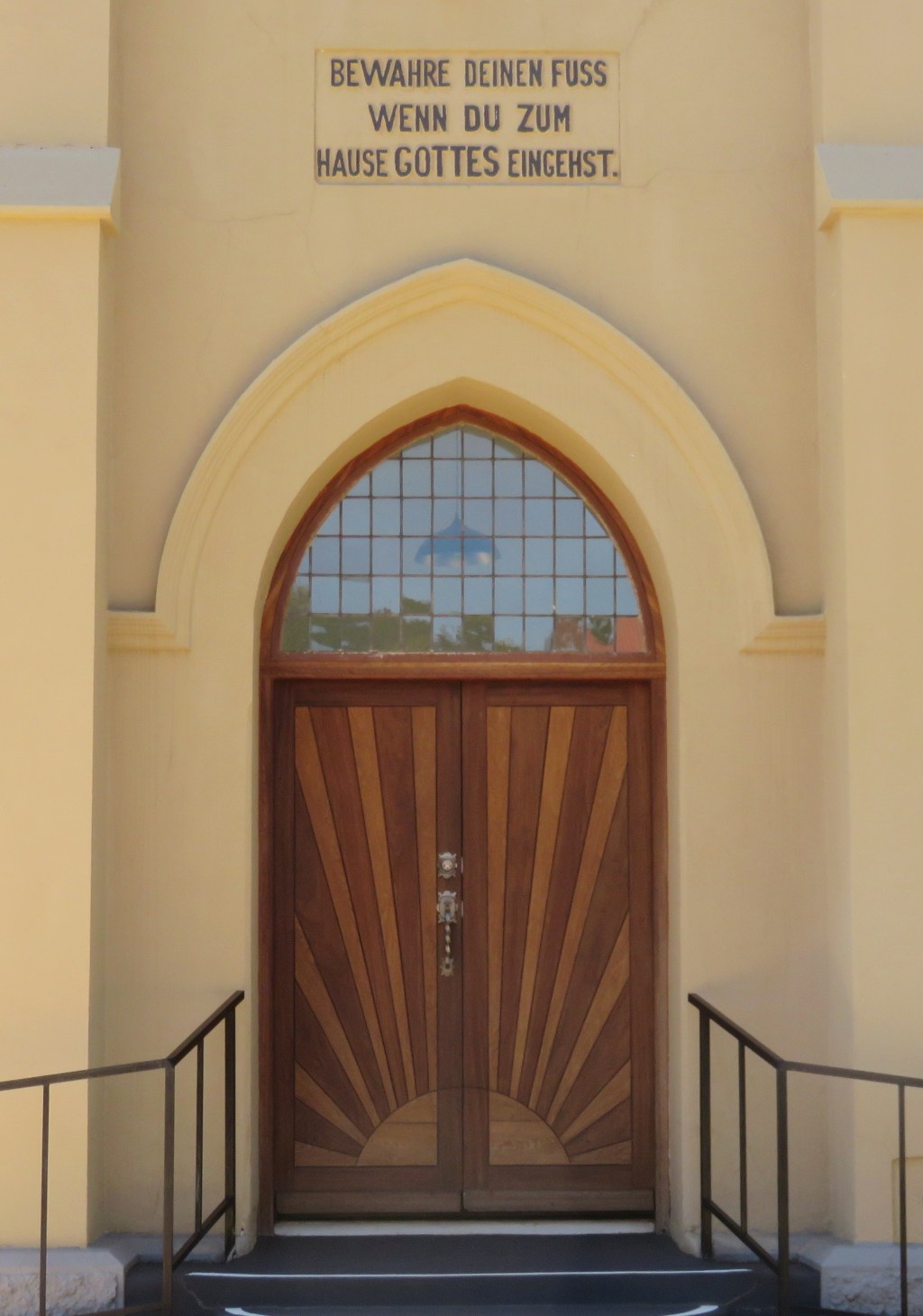
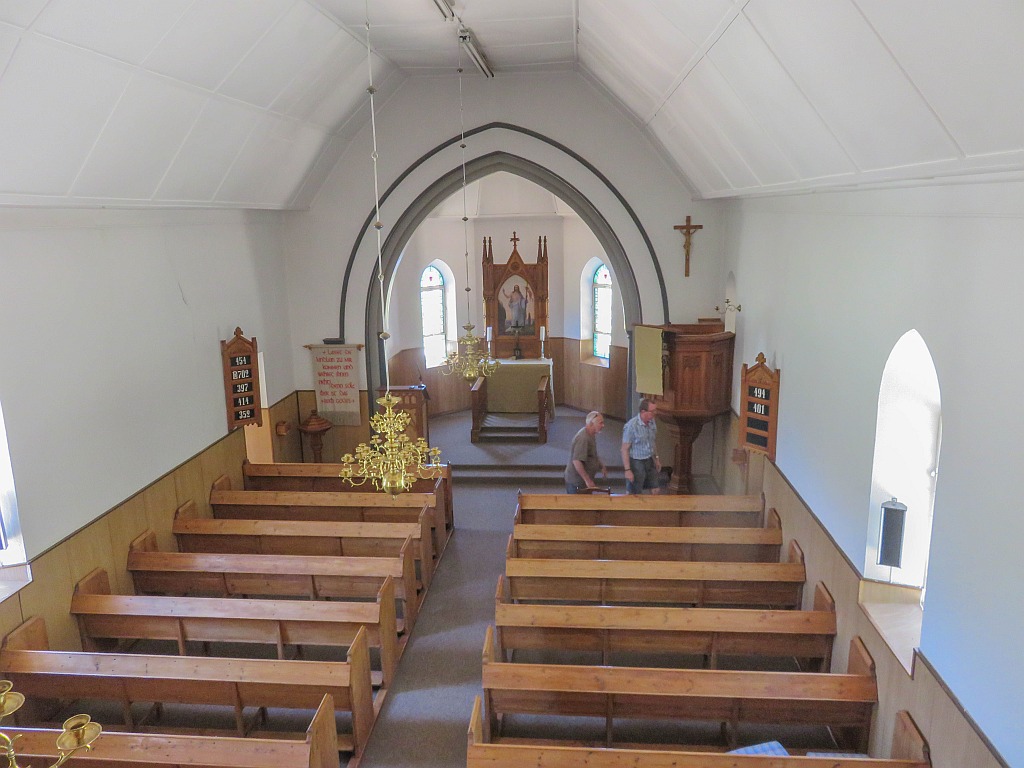 There is a verse above the door (picture on the left): 'Bewahre deinen Fuss wenn du zum Hause Gottes eingehst.' I have been puzzling what that could mean and have found it now. It's from the German Bible translated by Martin Luther, in 'Der Prediger Salomo' 4 Vers 17 it says: Bewahre deinen Fuss when du zum Hause Gottes gehst, und komme, daß du hörest. Das ist besser als der Narren Opfer; denn sie wissen ncht, was sie böses tun. For translation I opened the New King James version, the same verse is under Ecclesiastes 5 verse 1 and reads: Walk prudently when you go to the house of God; and draw near to hear rather than to give the sacrifice of fools, for they do not know that they do evil.
There is a verse above the door (picture on the left): 'Bewahre deinen Fuss wenn du zum Hause Gottes eingehst.' I have been puzzling what that could mean and have found it now. It's from the German Bible translated by Martin Luther, in 'Der Prediger Salomo' 4 Vers 17 it says: Bewahre deinen Fuss when du zum Hause Gottes gehst, und komme, daß du hörest. Das ist besser als der Narren Opfer; denn sie wissen ncht, was sie böses tun. For translation I opened the New King James version, the same verse is under Ecclesiastes 5 verse 1 and reads: Walk prudently when you go to the house of God; and draw near to hear rather than to give the sacrifice of fools, for they do not know that they do evil.
There is an article in the heritage portal covering this church.
Braunschweig Cemetery
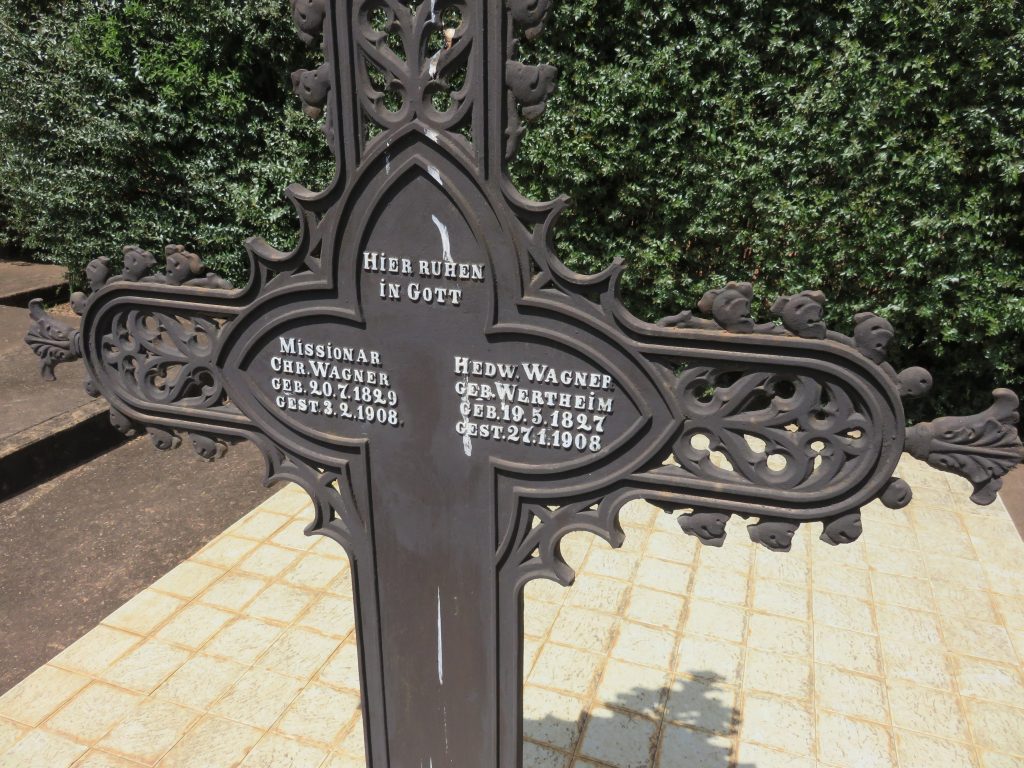 The cemetery in Braunschweig is near the church.
The cemetery in Braunschweig is near the church. 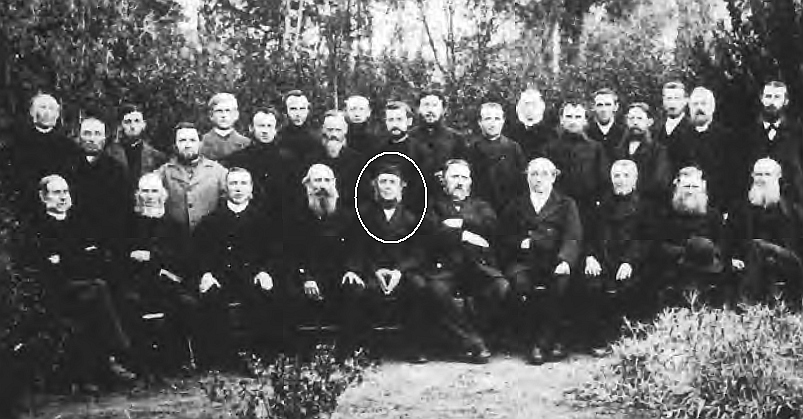 One of the graves that drew my attention was that of CHR Wagner, born 20-7-1829, died 3-2-1908. Christian Wagner was one of the early arrivals in Natal, 1862. Many of those years and especially the last years were spent at his mission station eNtombe, not far from Braunschweig. I actually found a
One of the graves that drew my attention was that of CHR Wagner, born 20-7-1829, died 3-2-1908. Christian Wagner was one of the early arrivals in Natal, 1862. Many of those years and especially the last years were spent at his mission station eNtombe, not far from Braunschweig. I actually found a 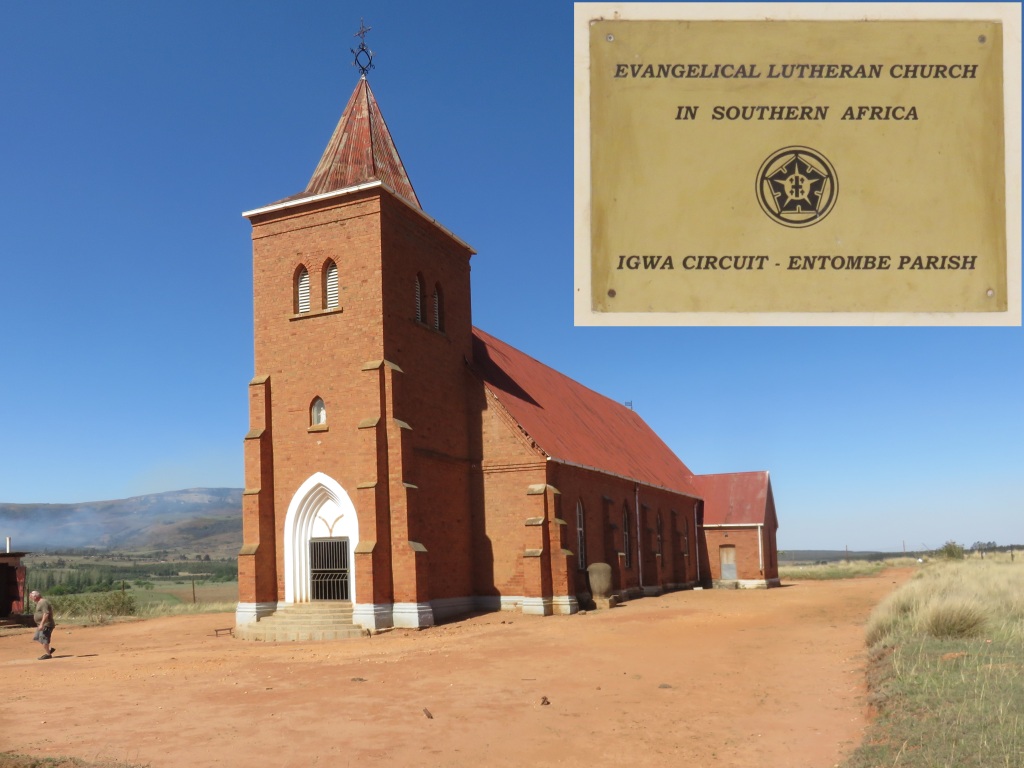 photograph of him in Ref 3, a picture supplied by the University of Natal Library. It was taken during a missionary conference in 1888.
photograph of him in Ref 3, a picture supplied by the University of Natal Library. It was taken during a missionary conference in 1888.
Most likely well after his time a church was build, see picture. I have no information about when the church was erected or who the architect was or who the builders were.
Intombi battle site

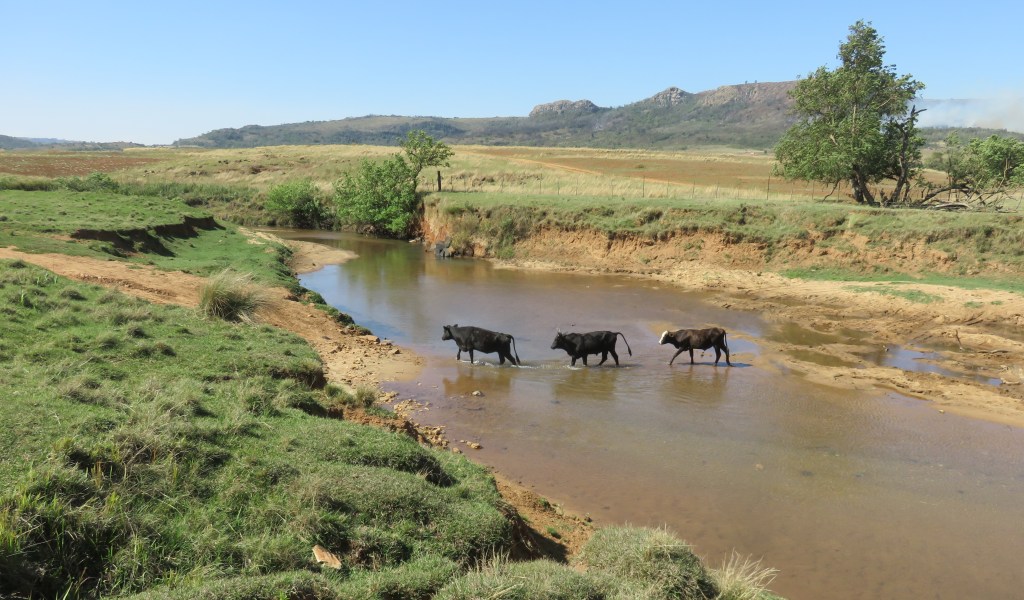 Not far from the Braunschweig church is the Intombi battle site. It goes back to the Zulu War and was a battle fought on the 12 March 1879. It was a major defeat for the British with 61 soldiers killed and supply and ammunition lost to the enemy.
Not far from the Braunschweig church is the Intombi battle site. It goes back to the Zulu War and was a battle fought on the 12 March 1879. It was a major defeat for the British with 61 soldiers killed and supply and ammunition lost to the enemy.
The British had set up a supply depot at Luneburg, supplies for it came mainly from Lydenburg by wagon trains. Such a convoy was on its way in February/March 1879. Progress was slow due to heavy rain and break downs. They came to a halt at the Entombe river, 6 miles from Luneburg, unable to cross because the river was in flood.
Captain Moriarty with a company of 106 soldiers was sent out from Luneburg with a wagon load of material to build a raft. It was obvious that the wagons could not cross the river on that day. They pulled the wagons together to form a defensive V, with the open end toward the river.
Early in the morning they were attacked by the impies. A problem was that the river had subsided somewhat opening a gap between the wagons and the river. It was a blood bath from which not many of the British survived. One of the first ones to perish was captain Moriarty.
A smaller group of 32 under the command of Lieutenant Harward had been placed on the south side of the river, they initially joined the fight by firing across the river until they themselves got attacked by the enemy having crossed the river in the north. Harward ordered his men to seek refuge in a nearby farm house and jumped on his horse to summon help from Luneburg.
When the help arrived it was all over, the group in the farm house had survived, all the others were dead. The final count was 62 soldiers killed and 17 of the wagoners. The number of Zulus killed is not known. The British are all buried in a mass grave near the drift, captain Moriarty and some other officers were buried in Luneburg.
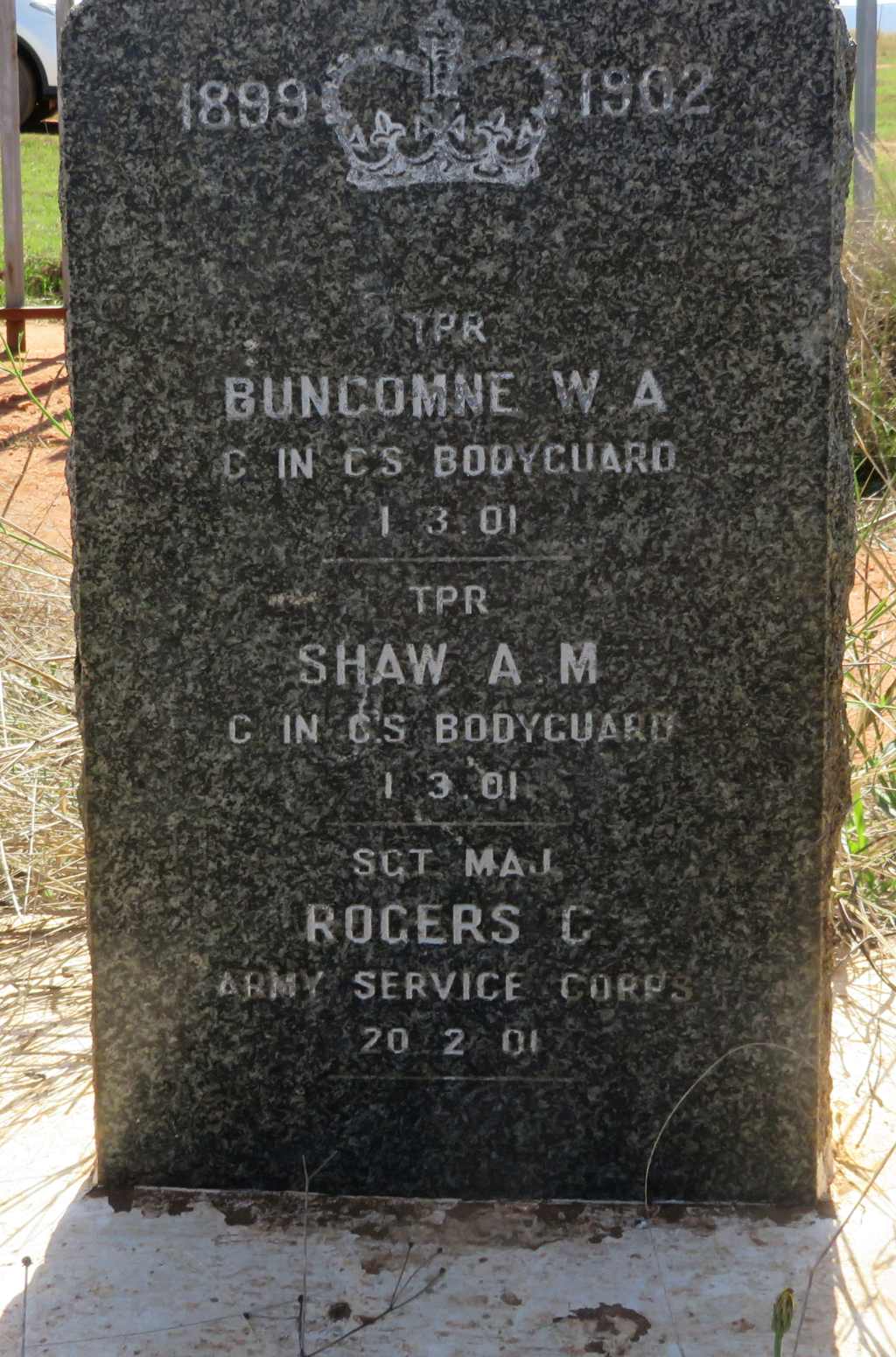 The 2nd Boer War also left its mark here. In the same enclosure is a stone commemorating Buncomne W.A., Shaw A.M., both bodyguards to the C in CS (I think stands for commander in chief), and also Sergeant Major Rogers C. I still have to find the details of what was happening here during the Anglo Boer war.
The 2nd Boer War also left its mark here. In the same enclosure is a stone commemorating Buncomne W.A., Shaw A.M., both bodyguards to the C in CS (I think stands for commander in chief), and also Sergeant Major Rogers C. I still have to find the details of what was happening here during the Anglo Boer war.
Just a note on the spelling, I have seen various ways of spelling the name: Entombe, eNtombi, Intombi, Ntombi, they are most likely all correct, I used mostly the spelling as in ref 4.
References
Ref 1.: Standard Encyclopedia of Southern Africa, Nasou Limited, 1974
Ref 2.: FROM THE LÜNEBURGER HEIDE TO NORTHERN ZULULAND A HISTORY OF THE ENCOUNTER BETWEEN THE SETTLERS,
THE HERMANNSBURG MISSIONARIES, THE AMAKHOSI AND THEIR PEOPLE, WITH SPECIAL REFERENCE TO FOUR MISSION STATIONS IN NORTHERN
ZULULAND (1860-1913), Submitted in fulfilment of the requirements for the Degree of Master of Theology in the School of Theology
University of Natal Pietermaritzburg, December 2002
Ref 3.: Lutherans, Germans:Hermannsburgers Natalia 22 (1992), H-J. Oschadleus
Ref 4,: Michael Barthorp, The Zulu War, Blandfort Press, 1980